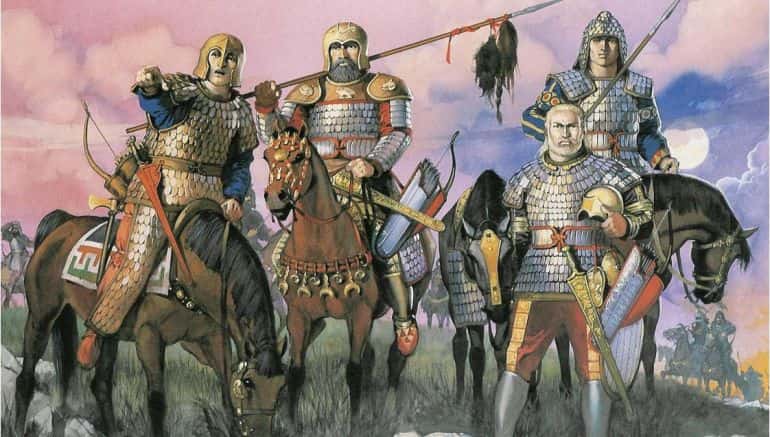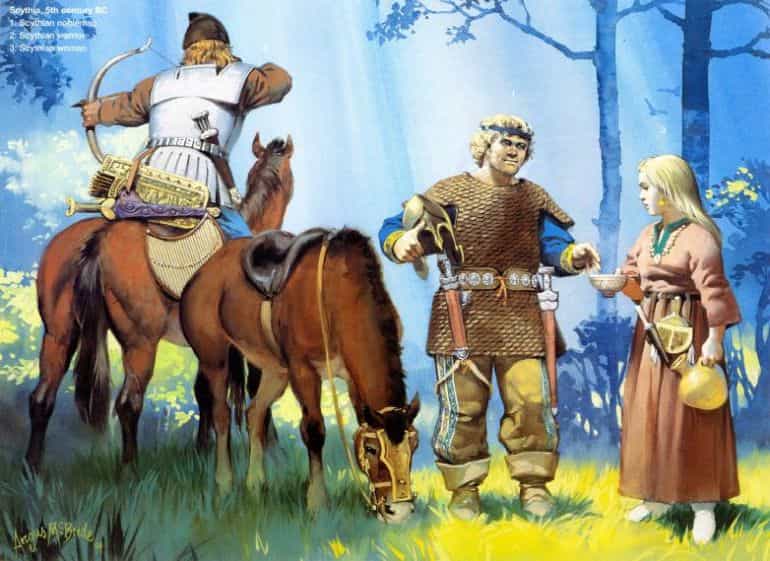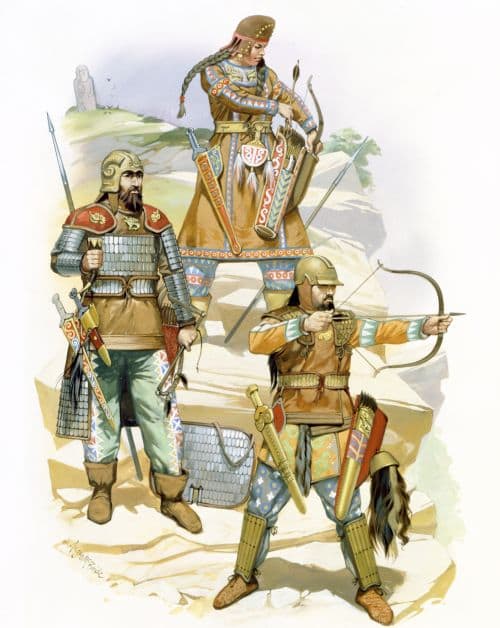
Overview of the Scythian horse archer (various refs for around the web).

About the Scythians
When talking about the Scythians as a people we are going to enter the realm between fantasy and legend, with little historical remnants to be content with. The Scythians were already known by Asiatic peoples in the late Bronze age. Their civilization is known to have dwelled and dominated the eurasian steppe for millenias. They were nomads living a shepherd life and their culture flourished from around 900 BC to around 200 BC, when they splitted up and part of the original people y assimilated by others, like the Sarmatians to the East, while the Saka were eventually assimilated in the Kushans. The Chinese even had the name for them, "Sai" while Saka was more Persian. They paid a tribute to the Persian king, however laterly, the Persians attempted to subdue them, without success. Their main advantage always have been their immense and desolated land, near-impossible to control, and with a harsh environment. Southrn Siberia was their ancient cradle but theyr quickly dominated and assimilated local cultures, advancing towards the west, the Black sea, while to the East, they reached India and dealt with the Xiongnu, well known by the Chinese as their turbulent northwestern desert barbarians.
CATW Scythian horse-archers: http://www.twcenter.net/forums/showthread.php?477236-Preview-Skytho-Sauromatae&styleid=41
Many sub-cultures has been assimilated to the Scythians. We known at least two very large groups, simplified in around 250 BC as the "western scythians" bordering the black sea and in contact with the Hellenistic world, while the "Eastern scythians" were also known locally as the "Saka Rauka" or "Royal Scythians". They had not the best reputation as a people, regularly preying on trade caravans or raiding the "civilized world", sometimes quite deep, like the Assyrians in around 700 BC. In all cases they left a considerable impression in many authors -both impressed and terrified- and since the XVIIth century thanks to the energic preservation initiated by King Peter the Great in Russia, the content of their burial tombs has been preserved from looting, giving much picturesque impressions of the people through many golden objects now at St Petersburg, as well as a mummy and its tattoes, a rug and relatively preserved clotings. Bas-reliefs were exceedingly rare. The Scythians left us only a fews burial mounts and votive stones, engraved "deer stones" on which the gods were honored by sacrificing slaves or precious animals such as horses.

Horse were vital to the Scythian civilization as they are today to all traditional nomads such as the Mongols. They moved their camps and guard their herds, helped hunting, and naturally were also their main warfare asset. The concept of horse-archer is litteraly synonim to a scythian warrior. Although they could fight on foot, "dismounted", their deeds were unrivalled when on a saddle with their powerful composite bow, the ultimate high technology weapon of the ancient world. They were a fearsome bunch which defeated any armies launched against them, fighting "like water", meaning they could assembled from small unitary tribes and individuals, droplets in the steppe, to larger groups which coalesced until shaping torrential masses of men, horses and arrows, and fought on a very fluid fashion as well, rarely engaging the enemy in a pitch battle.

The land and scorched earth policy helped them many time destroying far large conventional foot armies. They were eventually defeated and assimilated by fiercer nomads themselves, the Sarmatians, while the Parthians were latter assimilated by the Sassanids, and the latter by the Arabs and the Mongols. And what about the Amazons ? Nowadays most historians agreed these were real life batallion of women horse-archer in campaign, noblewomen and their retinues, that went in campaign to defend their lands just as men when the latter were far away in campaign. There would be the basis of the legend, after striking Greek settlers on the black sea. Many more cases would be studied in the future but we wil focus here on the horse-archers.

Skythoi Hippotoxotai: The Scythian horse archers
The archetypal scythian warrior was the horse-archer. In greek skythoi (scythian) hippo- (horse-mounted) toxotai (archer). We will focus here on the "basic", unprotected one which made by far the bulk of any scythian army. The average (not noble) horse archer was drawn from free herdsmen living their nomadic life, based on grazing seasons on the steppes. Horse archery was practiced very young, as both arts were difficult to master, especialy combined. Yet with time and ruthless dedications young free scythians, men and women alike, learned how to ride, and then how to fire arrow at all speeds, with ponpoint accuracy. This was a matter of survival: In the barren steppe, learning to hunt down potential preys like rabbits and all the fauna that lived on these wide expenses. And they became very proficient in this exercise.
Scythian horse archer tactics
In warfare, this means being capable to place their arrow on the very small surface (for example the unprotected eye of a footsoldier, his necks, arms and legs, while on the move, at a safe distance and full gallop. Combined with the right shoot-and-retreat tactics, this made harrassment in very large scale, day and night, a psychological weapon as much as using the terrain to their advantage. Soon any foot army, depleted of supplies, became usually easy targets for maurading scythians and the army was deprived of sleep, struck by fear, thirst and hungry, became weaker, despite their actual numbers. Then came the pitch battle, where these cavalrymen acing in small packs could surround and pepper their foe until they break formation, and then sending heavier shock cavalry to eploit the gaps further. When their formations were broken and men started to flee in panick, then the whole scythian cavalry fell upon them, destroying isolated groups one by one. They probably used a basic harrassing formation allowing them to be always on the move to avoid counterstrikes by arrows and javelins, the so-called "cantabrian circle" which was in fact widely used, including by American indians and most nomads.
Appearance of the Scythians
What did these horse archers looked like ? Physically, the Scythians originated from Northern Iran as they spoke a derivated language (scroll of texts in Khotanese Saka survived). Their aspect was of white caucasians with sometimes fair hair and clear eyes as it is common in Northern India, Iran, Syria, or the Caucausus (Circassians). They would have been themelves diverse because of intermarriage and illegitimate childs born from slaves, and the absorbtion of other sub-tribes. Of course esastern Sakas would have been more asian in appareance, with high-cheek bones, rounded headed, darker skin, slanted and often with a monolid (single eyelid) eyes, dark straight hairs. Physicality common to nowadays Kazakh peoples. We know also since the discovery of a mummy that Scythians were heavily tattoed, with religious symbology involving wild animals, hybrid and fantastic beasts and hunting scenes, preys and predators representing their conception of the world. Scythians were almost always represented bearded, with long hairs, left flowing. The "Sai" were well known by the Chinese also as they raided possibly on the 8th century BC, the northern state of Zhou in ancient China. The Persians lost two armies when trying to subdue them.


Society
 They love music, poetry, singing, drinking some beer or fermented milk beverages, easting cheese and meat, a highly caloric menu fit for these men always on saddle or living outside in harsh continental conditions. But they also smoke weed and cannabis in large quantities, used also for religious purposes and healing. Their society was socially rigid with classes, ranging from slaves to nobles surrounding the king. We don't known however anything about their political structure. However cross-culture was well present, as at least one Scythian Philosopher was well known in Greek circles, touring Greece, and their elites probably spoke Greek as they often equip themselves with Greek helmets and sometimes armor and many decorative items. We do have about a hundred scythian names in recorded history, mostly chieftains and kings. The greatest contacts occurred in Crimea, in and around the Bosporan Kingdom.
They love music, poetry, singing, drinking some beer or fermented milk beverages, easting cheese and meat, a highly caloric menu fit for these men always on saddle or living outside in harsh continental conditions. But they also smoke weed and cannabis in large quantities, used also for religious purposes and healing. Their society was socially rigid with classes, ranging from slaves to nobles surrounding the king. We don't known however anything about their political structure. However cross-culture was well present, as at least one Scythian Philosopher was well known in Greek circles, touring Greece, and their elites probably spoke Greek as they often equip themselves with Greek helmets and sometimes armor and many decorative items. We do have about a hundred scythian names in recorded history, mostly chieftains and kings. The greatest contacts occurred in Crimea, in and around the Bosporan Kingdom.
Composed of three major cities, this kingdom saw several populations mixing: Greek merchants and artisans, thracians and Scythian mercenaries. We do know much about scythian art thanks to the works of arts made either by the Scythians themselves or greek artisans and now at the Hermitage museum. The lingua Franca and dominant culture was Greek, probably influencing religious practices and names. In the fertile and sunny Bosporan region, which was also rich with cereals, it was not uncommon to see foot soldiers of Scythian origin, adopting greek and hellenistic tactics and equipment. A "scythian hoplite" was not an impossibility in that case. There has been two occurences of battles mixing around 50% infantry and cavalry, notably one opposing Satyrus with the Bosporan King.

The Scythian horse archer panoply
The average scythian hersman had a felt, large, thick, possibly doubled tunic with no cloak, and baggy trousers, to avoid legs irritation on the horse's flanks. It has been argued that the adoptions by the Gauls and later Celts of the trouser was due to the earlier adoption of their immediate neighbours, the Getai tribe (Northern Thracians), and Bastarnae in concact with them. Thanks to finds of textiles well preserved in the permaforst we known Scythian garments were often red, with elaborated decorations, colored spires and geometric patterns not unlike the Persians and Thracians. But their most recoignisable point was their cap, pointed and tall for the eastern cousins, more Thracian-like in the west. Made of reverse cow or horse hide, they protected well the cheeks in winter. In some cases, they could have been covered with leather or scale armor. We have no idea if Scythian had some form of leather jacket for protection under their tunics, but no proof was ever found in burials, often reserved for the upper class. For that reason, and the fact "cemeteries" were not compatible with a nomadic life, burials of commoners are incredibly hard to find, but perhaps servants and slaves buried with their masters.
The Scythian horse archer armament
Of course, armament was the focus of all attentions. Horse archers main weapon was their formidable composite bow (https://www.youtube.com/watch?v=qsgK8tuJquc). A marvel of ancient engineering, this was the combination of horn - compression - and sinew - extension (outside-inside) in a precise order both for strenght and flexibility, bonded by a fish-derived glue, but also leather and tressed sinew for the rope. Arrowheads were very diverse in hapes, forms and uses. Soe were designed to penetrate armor, or to inflict maximal damage on impact by brute force, cut ropes, be flamed, or whistle. And they were all carried in a dedicated large Gorytos, the typical Scythian scabbard also carrying parts to repair the bow or even a replacement bow. Next, we have a dagger, often a reduced version of the Persian Akinakes, used for daily uses, carving stuff, cutting wood, bone or meat. Next, melee weapons were variable. The most common were the Persian Akinakes, a long dagger used to fight other cavarymen on saddle on close quarters, but also javelins in complement to the bow, spears for the same use, and of course the most characteristic infantry killer: The Sagaris. This was a characteristic pick-axe. It was expecially designed with a small hammer on one extremity and a sharp point on the other to be used to pierce through armor or use blunt force against a footsoldier.About Scythian Horses
Their horses were variable in size and height. These nomadic horses were relatively small (yet larger than their western counterparts), fast, muscular, hardy and agile. They were assimilated to whatever was sacred to the Scythians and great care was placed upon them. Killing a horse (outside religious ceremonies) would have been the supreme outrage and penatly of death was immediate. We often have representation in some assimilated tribes like the Massagetae, of decorations and helmets used in burials and destined to give them a surnatural, hybrid beast look. We do not know but it's unlikely if this kit was also used in wartime. These horse went unarmoured exception of Kings mounts and their retinue and possible late scythian cataphracts. We known their nemesis, the Sarmatians, often used scale armor on their horses. It was easy indeed to kill the mount, and a dismounted foe was easier to kill. They had a modern addle and decorations consisting also of scalps, taking to the enemy as proof of their deeds.
Scythian horse archer mercenaries and in litterature
Acient literrature is perhaps even richer on Scythians than Gauls, to the point they became Greek's typical bugbear, typical children's nighmarish entity in the mode "... or the scythian will catch you". Their barbarian flair came with niceties like drinking human blood, eating raw flesh, making objects from human skin, skinning their victims alive and of course scalping. But just like the gauls they were feared and respected and passed for the best horse archer in the world and the only north-eastern nomadic culture the civilized world was in contact. The first scythian mercenaries were used by the Athenians, through their network of client city-states, including the Bosporans. First contacts also appeared through the Pontic kingdoms reports when on the 8th century BC. Herodotus reported their raids along the Caucasus and black sea, and near-destruction of the Cimmerians. Later, they raided Assyria and were also well recorded locally. There, they were assimilated to the Timber Grave culture.
Saka horse archer (Eastern Scythians) with the typical high pointed cap.
In Classical Antiquity (600 BC to AD 300) Persians attempt to subdue to Scythians in order to avoid further raids in their empire, failed, in 512 BC. King Atheas later moved on the Maeotis lake and raided Macedon. He was defeated time and again by Philip II of Macedon but established strongholds around 339 BC beyond the Danube. However Sarmatian pressure pushed the Scythians westwards, and many settled in Crimea. They became more available as mercenaries. Described as "fighting to live and living to fight" these mercenaries often used, mounted or dismounted, deadly barbed and poisoned arrows. As archers they were unmatched due to the range, speed and accuracy of their volleys. They were prized both in foot armies, as cavalry auxiliaries and in sieges where their sagaris made for a formidable assault infantry. In the end, Scythians were also found acting as policemen in many cities including Rome, as well as natural horse-breeders and trainers.



Sources/Read More
On the British Museum - Sept. 2017 ExpositionGeneric - The scythians on Wikipedia Wonderful art about ancient nomads
♕ Aquitani & Vasci ♕ Celts ♕ Indo-greeks ♕ Veneti ♕ Yuezhi ♕ Indians ♕ Etruscans ♕ Numidians ♕ Samnites ♕ Judaean ♕ Ancient Chinese ♕ Corsico-Sardinians
⚔ Cingetos ⚔ Immortals ⚔ Cavaros ⚔ Cataphract ⚔ Romphaiorioi ⚔ Chalkaspidai ⚔ Devotio Warrior ⚔ Scythian Horse archer ⚔ The Ambactos ⚔ Iberian warfare ⚔ Illyrian warriors ⚔ Germanic spearmen ⚔ Carthaginian Hoplite ⚔ Thracian Peltast ⚔ Caetrati ⚔ Ensiferi ⚔ Hippakontistai ⚔ Hastati ⚔ Gaesatae ⚔ Cretan Archer ⚔ Thorakitai ⚔ Soldurii ⚔ Iphikrates ⚔ Kardaka ⚔ The thureophoroi